|
Basics of Cattle Handling
By Bob King of Bob King's Cowboy School
The increasing popularity of team penning and other forms of competition involving cattle have
given riders many opportunities to have fun with their horses. To increase your effectiveness and
odds of wining in these sports, and to improve your enjoyment, there are several fundamentals of cattle work that everyone should understand before they begin.
Put simply, you need to be familiar with the recognition zone, flight zone, fight zone, and
the positions for driving, blocking, turning and pressure and release.
In the interest of space, this article will deal only with the recognition, flight and fight zone. There
are infinite refinements to each of these, but to help the novice begin working cattle we will keep it
very simple. It might help the novice to think of the space around the cow, or the herd, as a series
of concentric circles, spiraling outward. The size of each of these circles varies with each cow or
in the case of the herd, with the wariest member of the herd. This isn’t a perfect analogy, because
these spaces aren’t perfectly round, but for our purposes it will serve to provide a useful mental image.
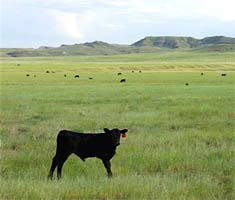
The outermost circle is the recognition zone.
Here the cow sees and identifies someone or something without feeling the need to move away. We may see the animal lift its head and watch us, or the signs may be
more subtle. We need to be observant, learn to recognize those signs and be prepared for the response when we move into the flight zone.
The flight zone
is that place or distance where the cow feels pressure or the need to move away. 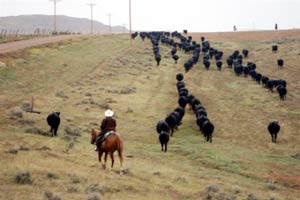 It is what allows us to move herd animals, and
just as the recognition zone varies widely from cow to cow, or from one moment to the next with the same cow, so does the flight zone. Once the flight zone is entered there is energy
generated and we direct and control that energy by our movements. Learning to recognize the flight zone of each animal isn’t difficult; however, it does require observation
and attention to animal to avoid misusing it. While a wild range cow will take off at a high
trot as soon as it sees a human, a tamer cow in a pen might have a flight zone of just a few feet, or even inches. Once we are aware of it and understand how positioning works, we can avoid
common errors such as running a cow past the gate or inadvertently stopping the flow of the herd;
just a few of the mistakes that can make us unpopular at a roundup or competition. It is possible, through incorrect handling, to spoil the flight zone and create a disrespectful animal that will
actually run into a horse and rider rather than move away, but for the moment we will assume that
you will be working with an animal that is still respectful and yet isn’t going to disappear over the horizon at first glance. It is what allows us to move herd animals, and
just as the recognition zone varies widely from cow to cow, or from one moment to the next with the same cow, so does the flight zone. Once the flight zone is entered there is energy
generated and we direct and control that energy by our movements. Learning to recognize the flight zone of each animal isn’t difficult; however, it does require observation
and attention to animal to avoid misusing it. While a wild range cow will take off at a high
trot as soon as it sees a human, a tamer cow in a pen might have a flight zone of just a few feet, or even inches. Once we are aware of it and understand how positioning works, we can avoid
common errors such as running a cow past the gate or inadvertently stopping the flow of the herd;
just a few of the mistakes that can make us unpopular at a roundup or competition. It is possible, through incorrect handling, to spoil the flight zone and create a disrespectful animal that will
actually run into a horse and rider rather than move away, but for the moment we will assume that
you will be working with an animal that is still respectful and yet isn’t going to disappear over the horizon at first glance.
If we push past the flight zone we end up in a place we don’t normally want to go:
the fight zone.
In this space the critter feels trapped and has a need to defend itself. It may turn and face the
rider, rather than move away. It may also shake its head in warning or frustration and back up a
few steps before things get wild. If you persist in putting pressure on the cow it may do a number
of things, but the most common ones are pushing between two horses, ducking under the neck of the horse, pushing between the horse and a solid object such as a fence, hooking the horse, or
running into it.
Once your begin to recognize and use these zones you can use your position more effectively and
start using the release of pressure to get the results you want.
These are just a few of the concepts we teach at Cowboy School. Once students have had a chance to practice these techniques, and others, in a controlled situation with just a few cows, we
can take them into a working situation and they will have a good chance of being useful and enjoying themselves.
Basics of Cattle Handling II about driving, blocking, turning and pressure and release.
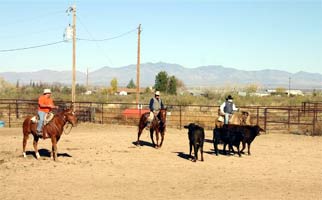 Most of the time, humans underrate the intelligence of cattle or other herd animals. Cattle learn quickly, efficiently and retain what they learn for long periods of time.
The trick is to understand how they operate and only teach what you want them to learn. Once you have an understanding of the recognition, flight and fight zones you can begin to use your
position in relation to the cow and your pressure and release more effectively. This will teach the cow to respond in a way that is helpful to you. Because you are now aware of the
recognition zone you can move into position before crossing into the flight zone and putting pressure on the cow.
Most of the time, humans underrate the intelligence of cattle or other herd animals. Cattle learn quickly, efficiently and retain what they learn for long periods of time.
The trick is to understand how they operate and only teach what you want them to learn. Once you have an understanding of the recognition, flight and fight zones you can begin to use your
position in relation to the cow and your pressure and release more effectively. This will teach the cow to respond in a way that is helpful to you. Because you are now aware of the
recognition zone you can move into position before crossing into the flight zone and putting pressure on the cow.
Pressure, mental or physical, is what causes the animal to move, while release of pressure is what
signals the animal that a particular movement was the correct thing to do. For example, if you ride
up behind a cow into its flight zone that puts pressure on the animal and it moves forward, the
distance between it and you increases and the pressure becomes less. That feeling of no pressure is just what the cow is looking for and provides a reward for moving forward. If you move
forward again, the pressure increases once more, the cow moves forward and the pressure decreases again. Pressure causes the animal to look for a way out, while release of pressure
reinforces the behavior that just occurred.
Next, think about what happens when you put too much pressure on the cow, or put pressure on
when you should release it. At that point the cow is getting stressed and frustrated, a situation that
usually causes problems. The cow may get “on the fight,” jump a fence, or run into a fence, a
horse, or a human. It may just go way too fast, or run past the gate, or chute or trailer door you
were trying to get it to go through. We have all seen situations when the rider went at the cow(s)
too fast, or was making too much noise, either visual or auditory noise, and it looked like bowling
for cattle when cows took off in all directions. If you have ever felt as if you are herding chickens rather than cows you have been there.
It may be harder to see when you are pressuring at the wrong time or not giving a release, or reward, for the correct movement. Maybe the cow was moving toward the gate a little slow, but
was looking at it, which means it was thinking about going there. If at that time you put on additional pressure the cow could decide that going through that gate was a bad idea after all.
You just made the right thing difficult. (Have you witnessed that situation, but labeled the cow
stubborn or stupid?) On the other hand, if you released pressure at the moment the cow looked at the gate, perhaps by stopping the horse, or even backing up a step or two, the cow was
rewarded for thinking about the gate, and was more likely to go through it. Try not to take things
personal. The cow doesn’t care what your plans are, but if you make it think that it can escape you by going through the gate it will go.
In addition to putting on the right amount of pressure and releasing it at the correct time, you need
to put pressure on the right spot. Visualize the cow as being divided into three parts, the area
from the hip bone to the tail, the body between the hip and the head, and the head. Approaching
the cow from behind and slightly to one side or at a right angle to the hip will cause a forward
motion. (If you approach from directly behind you are out of the animal’s range of vision and it will be inclined to stop and turn around to keep you in sight.)
Moving along the side of the cow, to the shoulder will slow or stop the motion, and moving to the
head will encourage the cow to turn away from you. It is very simple and works on all herd
animals, so if it is a new idea, get on foot and try it with your horse in the round pen first. Drive it
from behind or at the hip, move the pressure toward the shoulder to slow or stop the movement and step to the head, putting pressure on the eye to turn the horse.
Experiment to see just how much pressure it takes to get the job done, being careful not to get kicked. If you have ever tried to drive your horse forward while free-lunging and it kept stopping,
you were probably applying pressure too far to the front without realizing it. Animals are so
sensitive that the difference between the correct position and the incorrect position may only be a
couple inches. It is fun to play with this concept, so don’t be afraid of trial and error. It is the best way to learn.
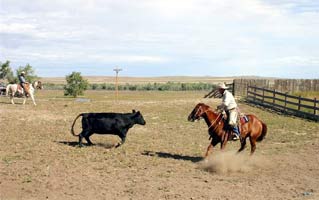 There are refinements to all the movements:
for example, if you ride directly toward the hip then continue to pressure that hip as the animal moves forward you can cause it to turn in a circle toward you. Or you can
ride to the eye and initiate the circle away from you. What works for one cow also works for the herd. Let me give you a “for instance” Bob might use in Wyoming at Bob King’ Cowboy School. When bringing in the yearlings he might begin by
having all the riders behind the herd, driving them forward. If he wanted to change directions, say
to go to the right around the pond, all riders would shift position slightly to the left and the rider
furthest to the left would swing wide, and then ride forward until she was putting pressure on the
left side of the lead cows. The herd would swing to the right and that rider would then drop back
and rejoin the other students, who were busy maintaining forward motion. That would be
pressure and release at work. Ideally, all riders would continue to ride in a line behind the herd
until it was time to change directions again. Surrounding the herd with riders, a common strategy to keep control, really slows forward movement, and often creates another problem; too much
pressure, causing cows to look for an escape route to the right, left or behind a rider. There are refinements to all the movements:
for example, if you ride directly toward the hip then continue to pressure that hip as the animal moves forward you can cause it to turn in a circle toward you. Or you can
ride to the eye and initiate the circle away from you. What works for one cow also works for the herd. Let me give you a “for instance” Bob might use in Wyoming at Bob King’ Cowboy School. When bringing in the yearlings he might begin by
having all the riders behind the herd, driving them forward. If he wanted to change directions, say
to go to the right around the pond, all riders would shift position slightly to the left and the rider
furthest to the left would swing wide, and then ride forward until she was putting pressure on the
left side of the lead cows. The herd would swing to the right and that rider would then drop back
and rejoin the other students, who were busy maintaining forward motion. That would be
pressure and release at work. Ideally, all riders would continue to ride in a line behind the herd
until it was time to change directions again. Surrounding the herd with riders, a common strategy to keep control, really slows forward movement, and often creates another problem; too much
pressure, causing cows to look for an escape route to the right, left or behind a rider.
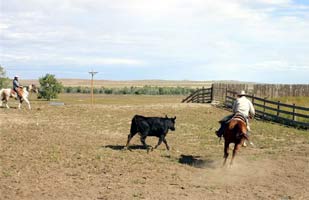 To move them through the open gate, which
would be on the left, one rider would move to the right and ride forward, timing his movement so he is in position to encourage the lead cows to look to the left and find the opening. To move them through the open gate, which
would be on the left, one rider would move to the right and ride forward, timing his movement so he is in position to encourage the lead cows to look to the left and find the opening.
One common error to beware of: do not cut off the movement of the cattle by getting between them and the gate. All this sound terribly elementary, but it is a challenge to be
at the right place, at the right time, with just the right amount of pressure. Sometimes you will wonder why the herd is going in the wrong
direction, and when you look around you see a rider, with the best intentions in the world, in precisely the wrong spot to get the cattle where you want them to be. Maybe that
rider is you. That’s how the learning process works. When that happens, everyone adjusts
position to fit the situation and starts over. The need to be always thinking, reacting and fine-tuning your position is what makes cattle work fun.
Remember, if you don’t have access to cows to practice on, these principles work just as well
with a horse. Turn it loose in a pen approximately 50 feet in diameter, and see where you need to
be to get results. Be respectful of the horse’s sensitivity, don’t go at it like a mountain lion, but do
carry a halter or flag, in case your horse is disrespectful and you need to reinforce your requests, and then enjoy the learning experience.
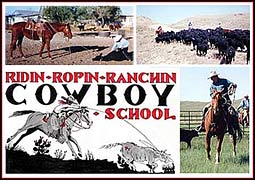
Contact: Bob King
385 W. Kaibab Way
Cochise, Arizona 85606
Phone: 888-596-3304
Email: cowboyschool@vtc.net
Website: www.cowboyschool.net
|